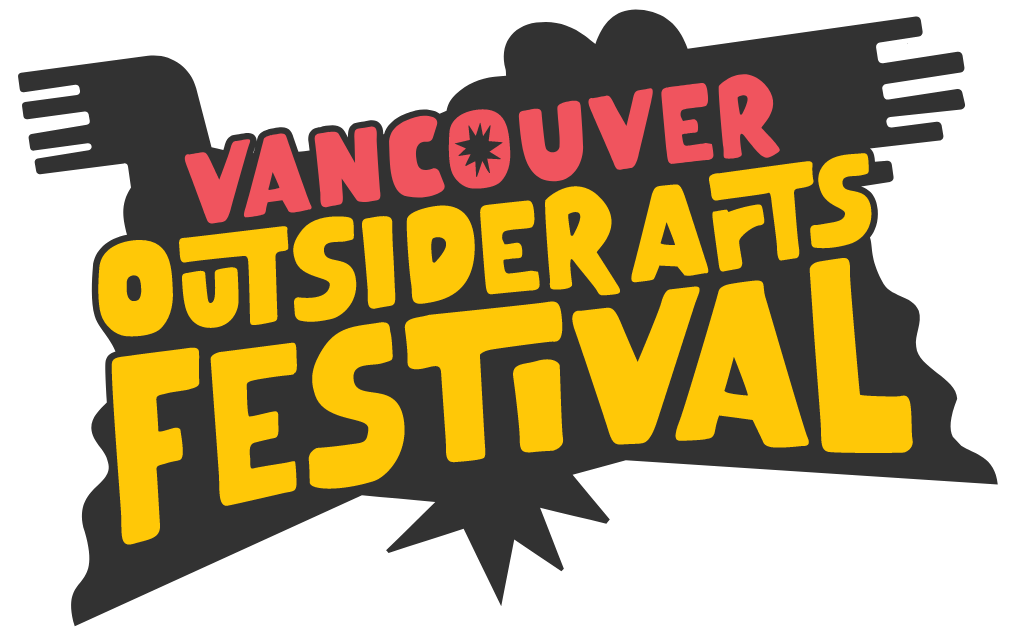VOAF 2022 Artist: Tim Varro
Tim Varro (he/him) is a retired art/media teacher turned artist and ICSI patient showcasing his sculptures at the 6th Annual Vancouver Outsider Arts Festival at the Roundhouse from October 14-16.
He has discovered that working with clay offers him a way to move beyond his disability (ICSI patient-MVA 1976) to a more light-hearted engagement, an innate quirkiness and an off-centred approach to his work.
Click here for more information about the artist.
This interview has been shortened for clarity and consistency.
How do you think your artwork connects to “outsider arts”?
I have, for the majority of my life, been surrounded by the creation of artwork. Although, as an art teacher, I chose not to pursue a career as an exhibiting artist. I knew it would undoubtedly detract and pull me from my energy and time to become the best teacher I could be. One cannot occupy both the chair of an artist and a teacher and do justice or even a palatable job of either one. So I chose the teacher’s chair, leaving the artist’s chair till I was no longer teaching.
What type of barriers do you face to creating artwork?
I am an ICSI patient. I have been so since 1976. Most of my life since then has been a journey where I regularly have to recalculate my plans in light of my current condition. I would often try to develop to compensate for my lack of abilities. I have come to understand the challenges and disappointments that are a part of life for some, yet for others, it reframes their life.
How can CACV help reduce these barriers and support advancement in your creative practice?
I am not sure; I have rarely attempted to employ my ICSI situation to advance anything I do. I do not want to be known for my reduced health and medical condition but rather for who I am, what I stand for and what I present of myself.
Where did you get the inspiration for the artwork you are exhibiting? Who are your influences, and what other artists inspire you?
I come from a family of “makers” – builders, designers, and artists. My eclectic style grew out of the synergies that evolved over my youthful years, observing my father present “chalk talks” in Sunday School, painting with him in his basement studio, learning how to use the potter’s wheel and getting the feel of working with clay. As a young boy growing up on Capitol Hill, I would spend hours playing with Dimitri Hardman (sculptor Jack Hardman’s son). I remember playing combat around the sculptures in their yard; they were just as tall as me and taller. I spent numerous summer vacations in Regina, Saskatchewan, where I was fascinated to watch my grandfather work; he was a skilled carpenter, a blacksmith and, later in life, a celebrated Saskatchewan folk artist documenting his early immigrant experiences. When visiting my Uncle Vic (Ciciansky) at his Craven art studio, I watched with fascination as he hand-built the remarkable and most unique clay sculptures.
Give a brief description of your creative process.
“I am often looking to explore avenues of the unexpected – an ironic twist to images or items you might not expect or their combinations, provoking a participant to imagine new and perhaps unexplored territory. Ideas or concepts that can have multiple meanings, like an oxymoron, analogies, or comparisons offer me to play around with various combinations. By revealing new relationships, offering up new metaphors and re-situating familiar icons of our collective reality into ‘unfamiliar contexts’, often in an off-centred and humorous fashion, I hope to challenge the viewer to reframe attitudes – or not.” But most important, the creative process must have a sense of the comical, on occasion offering a refreshing uplifting note. If I am to spend hours working in my studio, what I create has to lift me up first-then, the viewer.
What do you get up to when you’re not creating artwork?
I guess it would be reading, looking for ideas, taking care of household duties and advocating for the arts.
What are your goals in participating in the festival? Do you have any plans for after the festival or ways you hope the festival will help your practice?
I am looking to continue in the areas and direction of some of my recent sculptures, bas reliefs, western themes, and superhero subject matter, but with a more vigorous desire to try new ideas and techniques and revisit some earlier chicken clocks. –‘Re-hatched Chicken Clocks’.
What do you hope people take away from viewing your artwork at the festival? Do you want them to feel a specific emotion or come away with new ideas?
The pieces are created to take on various forms and interpretations intended to draw in the viewer and create new and unpredictable cycles of thoughts and associations, providing an experimental chance to challenge one’s perceptions, perspectives and assumptions.
